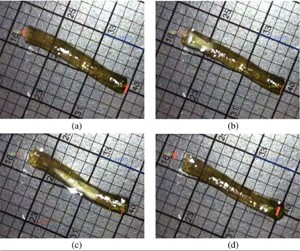
New Method of Wormlike Motion Lets Gels Wiggle through Water
Next time you spot an earthworm sliding through fresh dirt, take a closer look. What youre seeing is an organic movement called peristaltic locomotion that has been meticulously refined by nature.
Jarod Gregory, an undergraduate student in the University of Cincinnati's College of Engineering and Applied Science,
used a worms contracting and expanding motion to provide a way for gels to swim in water.
This is a product of work by the interdisciplinary team consisting of Jarod Gregory, a chemical engineering major, and his two advisers, Lilit Yeghiazarian, assistant professor of environmental engineering, and Vasile Nistor, assistant professor of biomedical engineering.
Phase one of his research titled, Remote-Controlled Peristaltic Locomotion in Free-Floating PNIPAM Hydrogels, is
published in the Journal of Applied Polymer Science
.
Published research is always an accomplishment within the world of academia, but it is especially significant when the primary author is an undergraduate student at the time of his research. Gregory is an ACCEND (ACCelerated ENgineering Degree) student who has just transitioned directly into UC's doctoral program in environmental engineering last month after earning a bachelor's of science in chemical engineering. This not-so-common achievement as an undergrad points to the significance of Gregorys research, also recognized by this years
.
When earthworms use peristaltic locomotion they engage with a surface, propel forward and detach. Gregory explains that peristaltic motion has previously been used by the team as a mechanism for movement for gels in frictional environments such as on solid ground or inside a tube. With Gregorys research, soft materials now have the ability to move freely without requiring outside friction, by using shrinking and swelling to move the center of gravity of an object in water - vastly expanding potential applications of soft materials and soon, soft robots.

The fluorescent image above (cross-section of a 5 mm diameter hydrogel) shows that the hydrogel adsorbs IR-820 primarily along its surface.
Gregory explains,
Using a hand-held laser, we were able to selectively and quickly shrink the hydrogel (a hydrophilic polymer gel comprised mostly of water) in desired areas. By inducing a shrinking/swelling cycle down the length of a hydrogel, we were able to successfully mimic peristaltic, or earthworm-inspired, locomotion in water.
According to Gregory, Studies have shown that hydrogels can be equipped to detect bacteria, carry cargo and deliver medicine. This new method of mobility expands the hydrogels use as an environmental and biotechnological tool by allowing them to explore new areas such as surface waters to combat toxic elements, or cavities inside the human body.
This research project started by Jarod Gregory with assistant professors Lilit Yeghiazarian and Vasile Nistor of the Department of Biomedical, Chemical, and Environmental Engineering in January of 2013 is a National Science Foundation-supported project. It was also a part of the NSF Research Experience for Undergraduates program at the University of Cincinnati for the 2013-14 academic year.
As Jarod Gregory continues into the next phase of his research, the world of soft materials is sure to reap the benefits.
For more information about the UC College of Engineering and Applied Science, please visit:
For more information about ongoing research at UC CEAS, please visit:
Related Stories
Information Security Roadshow spreads awareness
May 3, 2024
The University of Cincinnati's Office of Information Security launched a series of 18 in-person sessions from January to April 2024, drawing nearly 350 attendees from the staff of various UC colleges and units. The Information Security Roadshow series aimed to equip the audience with knowledge on prevailing cyber threats, prevention strategies, how to report incidents and resources to stay informed and secure.
Civil engineering professor honored with Titan of Industry award
May 1, 2024
Richard Miller, University of Cincinnati College of Engineering and Applied Science professor, was recently celebrated with the Titan of the Industry award by the Prestressed/Precast Concrete Institute, a technical institute and industry trade association.
UC recognizes students for innovation achievement and leadership
April 30, 2024
Read about the University of Cincinnati’s undergraduate innovation awards for 2024.
